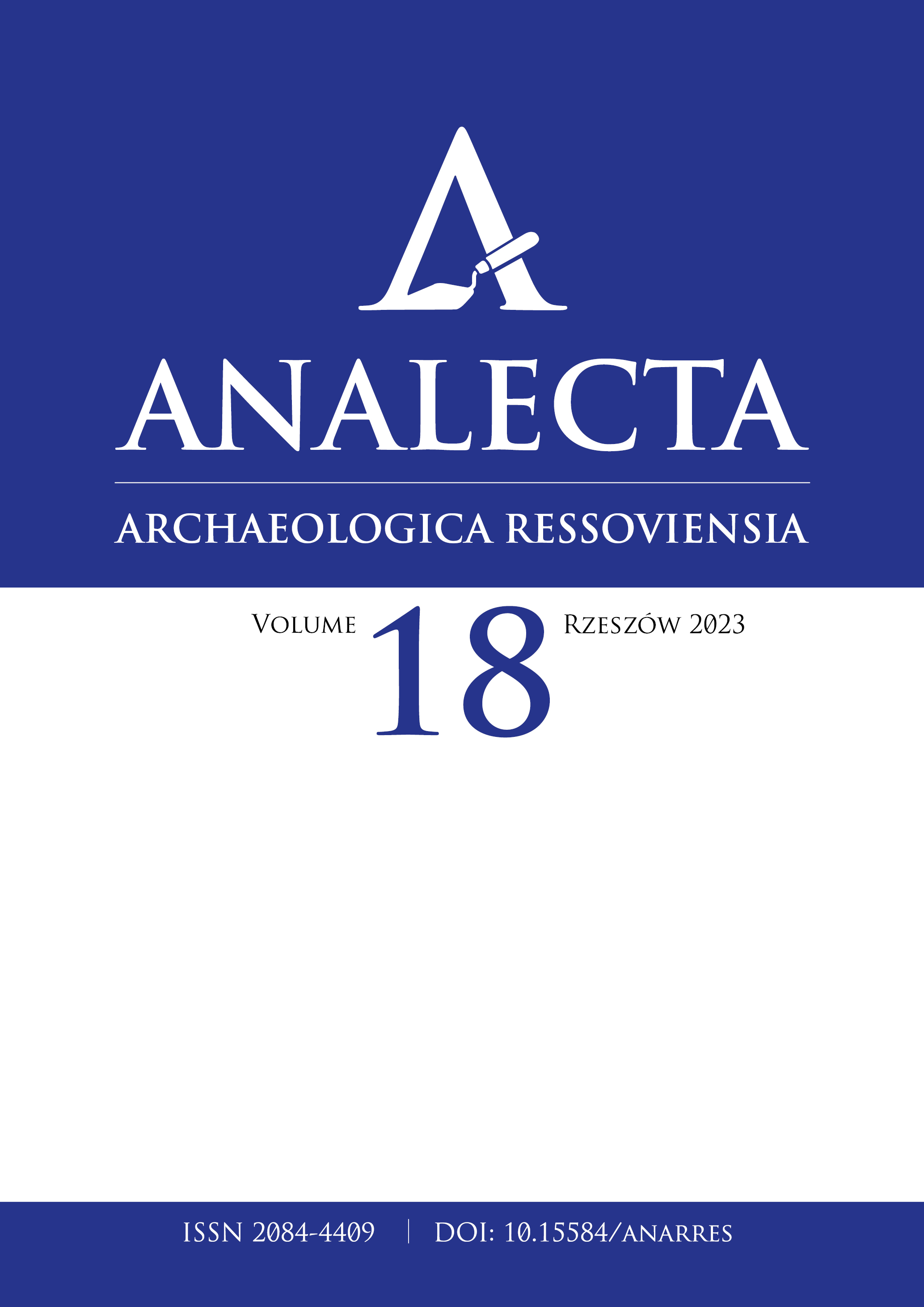A Contribution to the Study of Traces of Psychotropic Substances Inside Miniature Vessels and Collared Flasks of the Eneolithic Funnel Beaker culture (FBC) from Poland
DOI:
https://doi.org/10.15584/anarres.2023.18.6Keywords:
psychoactive substances, miniature vessels, Eneolithic, SE group of the FBC, Poland, GC-MS/MS, LC-MS/MSAbstract
The text presents the results of laboratory analyses conducted on vegetal intoxicating substances identified on the walls of selected pottery forms discovered at Polish sites attributed to the south-eastern group of the FBC. The samples taken from miniature vessels and collared flasks were examined using the GC-MS/MS method (triple quadrupole) and then the reference method LC-MS/MS (linear ion trap). As a result of the research, psychotropic substances were identified in four samples: papaverine, scopolamine and atropine.Downloads
References
Bargieł B., Kapica Z. and Śmiszkiewicz-Skwarska A. 1982. Grobowiec kultury pucharów lejkowatych w Wąwolnicy, woj. lubelskie. Wiadomości Archeologiczne 47(2), 239–245.
Bąbel T. 2006. Środki psychoaktywne w kulturach megalitycznych Europy Środkowej. Zarys problematyki. In J. Libera and K. Tunia (eds.), Idea megalityczna w obrządku pogrzebowym kultury pucharów lejkowatych. Lublin, Kraków: Instytut Archeologii Uniwersytetu Marii Curie-Skłodowskiej, Instytut Archeologii i Etnologii Polskiej Akademii Nauk. Oddział Kraków, 171–193.
Dąbrowski J. 2010. Uwagi o wiedzy medycznej ludności kultury łużyckiej. Materiały i Sprawozdania Rzeszowskiego Ośrodka Archeologicznego 31, 45–50.
Eliade M. 1988. Historia wierzeń i idei religijnych, 1: Od epoki kamiennej do misteriów eleuzyńskich. Warszawa: Państwowy Instytut Wydawniczy.
Filipova-Marinova M., Pavlov D., Vergiev S., Slavchev V. and Giosan L. 2013. Palaeoecology and geoarchaeology of Varna Lake, northeastern Bulgaria. Comptes rendus de l’Academie bulgare des Sciences 66(3), 377–392.
Furst P. T. (ed.) 1972. Flesh of the Gods. The Ritual Use of Hallucinogens. New York: Praeger Publishers.
Harner M. (ed.) 1973. Hallucinogens and shamanism. New York: Oxford University Press.
King A., Powis T. G., Cheong K. F., Deere B., Pickering R. B., Singleton E. and Gaikwad N. W. 2018. Absorbed Residue Evidence for Prehistoric Datura Use in the American Southeast and Western Mexico. Advances in Archaeological Practice 6(4), 312–327. DOI: 10.1017/aap.2018.30
Krzak Z. 1994. Megality Europy. Warszawa: Wydawnictwo Naukowe PWN.
Kulczycka-Leciejewiczowa A. 1997. Strachów. Osiedla neolitycznych Rolników na Śląsku. Wrocław: Instytut Archeologii i Etnologii Polskiej Akademii Nauk.
Kulczycka-Leciejewiczowa A. 2002. Zawarża: Osiedle neolityczne w południowopolskiej strefie lessowej. Wrocław: Instytut Archeologii i Etnologii Polskiej Akademii Nauk.
Kutyłowski A. 1974. Zgórzyńskie, pow. Puławy. Informator Archeologiczny. Badania 1973, 48.
Lityńska M. and Wasylikowa K. 2005. Przewodnik do badań archeobotanicznych. Poznań: Sorus.
López-Dóriga I. L. 2015. La utilización de los recursos vegetales durante el Mesolítico y Neolítico en la costa atlántica de la península ibérica [The Use of Plants during the Mesolithic and the Neolithic in the Atlantic coast of the Iberian Peninsula]. Tesis doctoral. Santander: Instituto Internacional de Investigaciones Prehistóricas de Cantabria, Universidad de Cantabria.
Madeja J. 2012. Local Holocene vegetation changes and settlement history based on pollen analysis of Lake Kwiecko sediments, West-Pomeranian Lake District, NW Poland. Acta Palaeobotanica 52(1), 105–125.
Merlin M. D. 2003. Archaeological evidence for the tradition of psychoactive plant use in the old world. Economic Botany 57(3), 295–323.
Motyka R. 1985. Mental imagery cultivation as a cultural phenomena. The role of visions in shamanism. Current Anthropology 26, 443–461.
Motyka M. and Marcinkowski J. T. 2014. Dlaczego zażywali środki psychoaktywne? Cz. I. Rola i znaczenie środków psychoaktywnych w kulturze: od pradziejów do początku XX wieku. Problemy Higieny i Epidemiologii 95(2), 223–233.
Noll R. 1985. Mental imagery cultivation as a cultural phenomena. The role of visions in shamanism. Current Anthropology 26, 443–461.
Nowak M. 2017. Ubiquitous settlers consequent farmers, and monument builders. In P. Włodarczak (ed.), The past societes. Polish lands from the first evidence of human presence to the early middle ages, 2: 5500–2000 BC. Warszawa: Instytut Archeologii i Etnologii Polskiej Akademii Nauk. Oddział Kraków, 125–170.
Röder B. 2010. Perspektiven für eine theoriegeleitete prähistorische Kindheitsforschung. Mitteilungen der Anthropologischen Gesellschaft in Wien 140, 1–22.
Rudgley R. 2002. Alchemia kultury. Od opium do kawy. Warszawa: Państwowy Instytut Wydawniczy.
Sherratt A. 1991. Sacred and Profane Substances: The Ritual Use of Narcotics in Later Neolithic Europe. In P. Garwood, D. Jennings, R. Skeates and J. Toms (eds.), Sacred and profane. Proceedings of a conference on archaeology, ritual and religion, Oxford 1989 (= Committee for Archaeology Monograph 32). Oxford: University of Oxford, 33–64.
Sikora T. 1999. Użycie substancji halucynogennych a religia. Perspektywy badawcze na przykładzie zagadnień rytuału i symbolizacji. Kraków: Zakład Wydawniczy NOMOS.
Smith R. K., Stacey R. J., Bergströma E. and Thomas-Oates J. 2018. Detection of opium alkaloids in a Cypriot base-ring juglet. Analyst 143, 5127–5136.
Sochacki Z. 1988. Zespół osadniczy kultury ceramiki promienistej w Krakowie-Zesławicach (= Prace Instytutu Archeologii UW 3). Warszawa: Wydawnictwa Uniwersytetu Warszawskiego.
Steiner D. 1997. Kindheit und Spiel. Archäologische Spuren. Archäologie der Schweiz 20(2), 97–101.
Szajt J. and Wieczorek-Kańczura K. 2018. Naczynia ceramiczne – forma i funkcja. In J. Piekalski and K. Wachowski (eds.), Rytm rozwoju miasta na kulturowym pograniczu. Studium strefy placu nowy targ we Wrocławiu. Część 1 (= Wratislavia Antiqua 23). Wrocław: Instytut Archeologii Uniwersytetu Wrocławskiego, 338–378.
Szmyt M. 2018. Relikty działań obrzędowych. In M. Szmyt (ed.), Mrowino, stanowisko 3. Późny neolit nad środkową Wartą (= Bibliotheca Fontes Archaeologici Posnanienses 22). Poznań: Muzeum Archeologiczne w Poznaniu, 525–531
Szyjewski A. 2001. Etnologia religii. Kraków: Zakład Wydawniczy NOMOS.
Zakościelna A. and Taras H. 2019. Ceramika eneolityczna ze stanowiska 1 w Dubecznie. In H. Taras (ed.), Dubeczno, stanowisko 1 (Pojezierze Łęczyńsko-Włodawskie). Materiały z badań archeologicznych w latach 1986–1987. Lublin: Uniwersytet Marii Curie-Skłodowskiej w Lublinie, Ars Libri S.C.
Zakościelna A. and Taras H. 2022. Miniature pottery forms of the Funnel Beaker culture from the Polish territories. In M. Dębiec, J. Górski, J. Müller, M. Nowak, A. Pelisiak, T. Saile and P. Włodarczak (eds.), From Farmers to Heroes? Archaeological Studies in Honor of Sławomir Kadrow (= Universitätsforschungen zur prähistorischen Archäologie 376). Bonn: Verlag Dr. Rudolf Habelt GmbH, 365–383.
Downloads
Published
How to Cite
Issue
Section
License
Copyright (c) 2023 Analecta Archaeologica Ressoviensia

This work is licensed under a Creative Commons Attribution-ShareAlike 4.0 International License.

